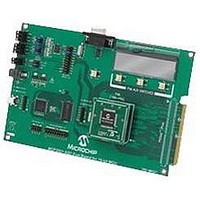MCP3901EV-MCU16 Microchip Technology, MCP3901EV-MCU16 Datasheet - Page 26

MCP3901EV-MCU16
Manufacturer Part Number
MCP3901EV-MCU16
Description
BOARD EVAL FOR 2CH ADC MCP3901
Manufacturer
Microchip Technology
Datasheets
1.MCP3901A0-ISS.pdf
(60 pages)
2.MCP3901A0-ISS.pdf
(30 pages)
3.MCP3901EV-MCU16.pdf
(38 pages)
4.MCP3901EV-MCU16.pdf
(38 pages)
Specifications of MCP3901EV-MCU16
Number Of Adc's
2
Number Of Bits
24
Data Interface
SPI™
Inputs Per Adc
1 Differential
Input Range
±1 V
Voltage Supply Source
Analog and Digital
Operating Temperature
-40°C ~ 85°C
Utilized Ic / Part
MCP3901
Silicon Manufacturer
Microchip
Application Sub Type
ADC
Kit Application Type
Data Converter
Silicon Core Number
MCP3901, PIC24F, PIC24H, DsPIC33, PIC18F86J55
Kit Contents
Board
Lead Free Status / RoHS Status
Lead free / RoHS Compliant
MCP3901
5.3.2
For a specified voltage reference value of 2.4V, the
modulators’ specified differential input range is
±500 mV. The input range is proportional to V
scales according to the V
ensuring the stability of the modulator over amplitude
and frequency. Outside of this range, the modulator is
still functional, however, its stability is no longer
ensured, and therefore, it is not recommended to
exceed this limit. The saturation point for the modulator
is V
includes a gain of 3 by default (independent from
the PGA setting). See
Coding”.
5.3.3
The
independent BOOST mode for each channel. If the
corresponding BOOST<1:0> bits are enabled, the
power consumption of the modulator is multiplied by 2.
Its bandwidth is increased to be able to sustain AMCLK
clock frequencies up to 8.192 MHz, while keeping the
ADC accuracy. When disabled, the power consumption
is back to normal and the AMCLK clock frequencies
can only reach up to 5 MHz without affecting ADC
accuracy.
5.4
If the user wishes to use the modulator output of the
device, the appropriate bits to enable the modulator
output must be set in the Configuration register.
When MODOUT<1:0> are enabled, the modulator
output of the corresponding channel is present at the
corresponding MDAT output pin as soon as the
command is placed.
Since the Delta-Sigma modulators have a 5-level
output given by the state of 4 comparators with ther-
mometer coding, their outputs can be represented on
4 bits. Each bit gives the state of the corresponding
comparator (see
the MOD register and are updated at the DMCLK rate.
In order to output the comparators result on a separate
pin (MDAT0 and MDAT1), these comparator output bits
have been arranged to be serially output at the AMCLK
rate (see
This 1-bit serial bitstream is the same as what would be
produced by a 1-bit DAC modulator with a sampling
frequency of AMCLK. The modulator can either be
considered as a 5 level-output at DMCLK rate or a 1-bit
output at AMCLK rate. These two representations are
interchangeable. The MDAT outputs can, therefore, be
used in any application that requires 1-bit modulator
outputs. These applications will often integrate and
filter the 1-bit output with SINC or more complex
decimation filters computed by an MCU or a DSP.
DS22192C-page 26
REF
Delta-Sigma
/3, since the transfer function of the ADC
Modulator Output Block
Figure
MODULATOR INPUT RANGE AND
SATURATION POINT
BOOST MODE
5-2).
Table
modulators
5-2). These bits are present on
Section 5.6 “ADC Output
REF
voltage. This range is
also
include
REF
and
an
TABLE 5-2:
FIGURE 5-2:
Function of the Modulator Output Code.
Since the Reset and shutdown SPI commands are
asynchronous, the MDAT pins are resynchronized with
DMCLK after each time the part goes out of Reset and
shutdown.
This means that the first output of MDAT after Reset is
always ‘0011’ after the first DMCLK rising edge.
AMCLK
DMCLK
MDAT+2
MDAT+1
MDAT+0
MDAT-1
MDAT-2
Comp<3:0>
Code
1111
0111
0011
0001
0000
COMP
<3>
DELTA-SIGMA MODULATOR
CODING
Output Code
Modulator
COMP
MDAT Serial Outputs in
<2>
© 2010 Microchip Technology Inc.
+2
+1
-1
-2
0
COMP
<1>
MDAT Serial
COMP
<0>
Stream
1111
0111
0011
0001
0000











